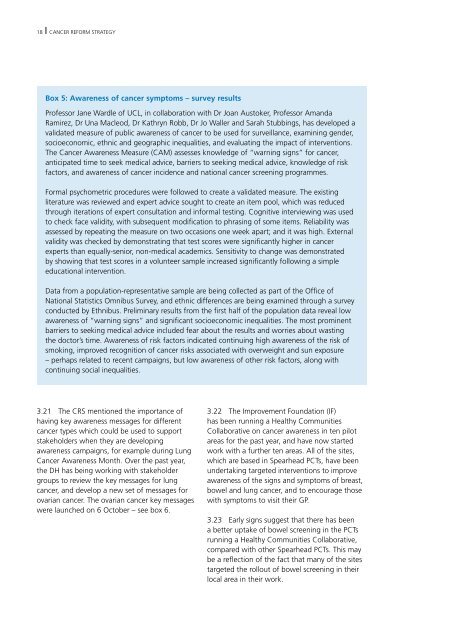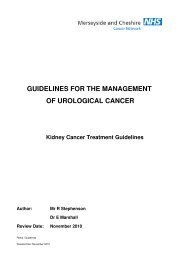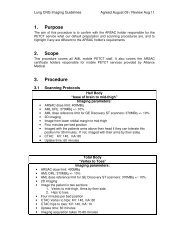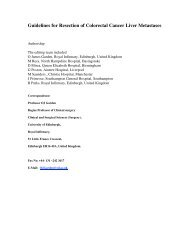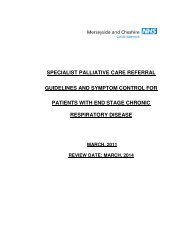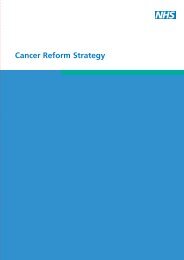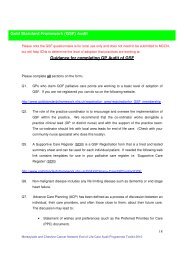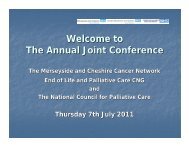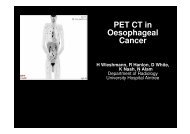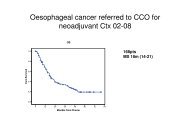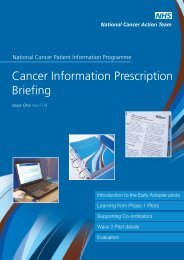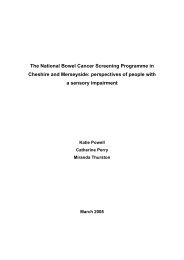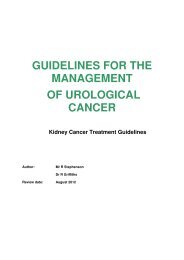Cancer Reform Strategy - First Annual Report - Merseyside ...
Cancer Reform Strategy - First Annual Report - Merseyside ...
Cancer Reform Strategy - First Annual Report - Merseyside ...
You also want an ePaper? Increase the reach of your titles
YUMPU automatically turns print PDFs into web optimized ePapers that Google loves.
18 CANCER REFoRM STRATEgyBox 5: Awareness of cancer symptoms – survey resultsProfessor Jane Wardle of UCl, in collaboration with Dr Joan Austoker, Professor AmandaRamirez, Dr Una Macleod, Dr Kathryn Robb, Dr Jo Waller and Sarah Stubbings, has developed avalidated measure of public awareness of cancer to be used for surveillance, examining gender,socioeconomic, ethnic and geographic inequalities, and evaluating the impact of interventions.The <strong>Cancer</strong> Awareness Measure (CAM) assesses knowledge of “warning signs” for cancer,anticipated time to seek medical advice, barriers to seeking medical advice, knowledge of riskfactors, and awareness of cancer incidence and national cancer screening programmes.Formal psychometric procedures were followed to create a validated measure. The existingliterature was reviewed and expert advice sought to create an item pool, which was reducedthrough iterations of expert consultation and informal testing. Cognitive interviewing was usedto check face validity, with subsequent modification to phrasing of some items. Reliability wasassessed by repeating the measure on two occasions one week apart; and it was high. Externalvalidity was checked by demonstrating that test scores were significantly higher in cancerexperts than equally-senior, non-medical academics. Sensitivity to change was demonstratedby showing that test scores in a volunteer sample increased significantly following a simpleeducational intervention.Data from a population-representative sample are being collected as part of the office ofNational Statistics omnibus Survey, and ethnic differences are being examined through a surveyconducted by Ethnibus. Preliminary results from the first half of the population data reveal lowawareness of “warning signs” and significant socioeconomic inequalities. The most prominentbarriers to seeking medical advice included fear about the results and worries about wastingthe doctor’s time. Awareness of risk factors indicated continuing high awareness of the risk ofsmoking, improved recognition of cancer risks associated with overweight and sun exposure– perhaps related to recent campaigns, but low awareness of other risk factors, along withcontinuing social inequalities.3.21 The CRS mentioned the importance ofhaving key awareness messages for differentcancer types which could be used to supportstakeholders when they are developingawareness campaigns, for example during lung<strong>Cancer</strong> Awareness Month. over the past year,the DH has being working with stakeholdergroups to review the key messages for lungcancer, and develop a new set of messages forovarian cancer. The ovarian cancer key messageswere launched on 6 october – see box 6.3.22 The Improvement Foundation (IF)has been running a Healthy CommunitiesCollaborative on cancer awareness in ten pilotareas for the past year, and have now startedwork with a further ten areas. All of the sites,which are based in Spearhead PCTs, have beenundertaking targeted interventions to improveawareness of the signs and symptoms of breast,bowel and lung cancer, and to encourage thosewith symptoms to visit their gP.3.23 Early signs suggest that there has beena better uptake of bowel screening in the PCTsrunning a Healthy Communities Collaborative,compared with other Spearhead PCTs. This maybe a reflection of the fact that many of the sitestargeted the rollout of bowel screening in theirlocal area in their work.


